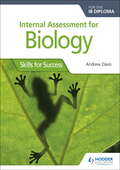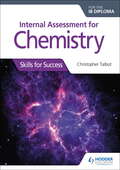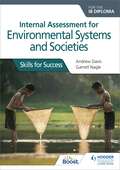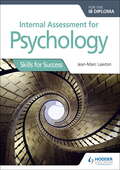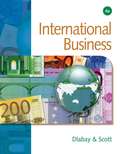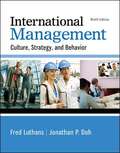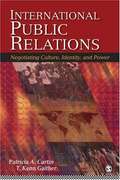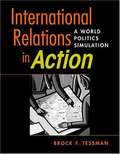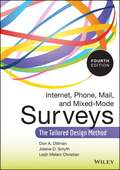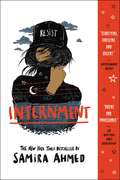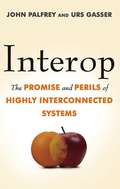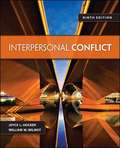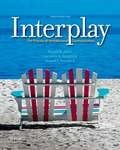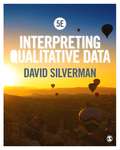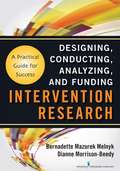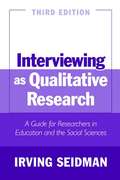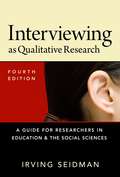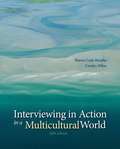- Table View
- List View
Internal Assessment for Biology for the IB Diploma: Skills for Success
by Andrew DavisAim for the best Internal Assessment grade with this year-round companion, full of advice and guidance from an experienced IB Diploma Biology teacher.- Build your skills for the Individual Investigation with prescribed practicals supported by detailed examiner advice, expert tips and common mistakes to avoid.- Improve your confidence by analysing and practicing the practical skills required, with comprehension checks throughout.- Prepare for the Internal Assessment report through exemplars, worked answers and commentary. - Navigate the IB requirements with clear, concise explanations including advice on assessment objectives and rules on academic honesty.- Develop fully rounded and responsible learning with explicit reference to the IB learner profile and ATLs.
Internal Assessment for Chemistry for the IB Diploma: Skills for Success
by Christopher TalbotAim for the best Internal Assessment grade with this year-round companion, full of advice and guidance from an experienced IB Diploma Chemistry teacher.- Build your skills for the Individual Investigation with prescribed practicals supported by detailed examiner advice, expert tips and common mistakes to avoid.- Improve your confidence by analysing and practicing the practical skills required, with comprehension checks throughout.- Prepare for the Internal Assessment report through exemplars, worked answers and commentary. - Navigate the IB requirements with clear, concise explanations including advice on assessment objectives and rules on academic honesty.- Develop fully rounded and responsible learning with explicit reference to the IB learner profile and ATLs.
Internal Assessment for Environmental Systems and Societies for the IB Diploma: Skills for Success
by Andrew Davis Garrett NagleSupport students through the Internal Assessment with advice and guidance including how to choose a topic, approach the investigation and analyse and evaluate results.- Build investigative and analytical skills through a range of strategies and detailed examiner advice and expert tips- Ensure understanding of all IB requirements with clear, concise explanations on the assessment objectives and rules on academic honesty, as well as explicit reference to the IB Learner Profile and ATLS throughout- Encourage students to achieve the best grade with advice and tips, including common mistakes to avoid, exemplars, worked answers and commentary, helping students to see the application of facts, principles and concepts- Reinforce comprehension of the skills with activity questions- Support visual learners with infographics at the start of every chapter
Internal Assessment for Psychology for the IB Diploma: Skills Success Epub
by Jean-Marc LawtonSupport progress through the Internal Assessment, walking students through criteria, how to choose a topic, approach experimentation and analyse and evaluate results for the final report. · Build skills through a range of strategies and detailed examiner advice and expert tips. · Ensure understanding of all IB requirements with clear, concise explanations on the assessment objectives and rules on academic honesty, as well as explicit reference to the IB Learner Profile and ATLS throughout. · Encourage students to achieve the best grade with advice and tips, including common mistakes to avoid, exemplars, worked answers and commentary, helping students to see the application of facts, principles and concepts. · Reinforce comprehension of the skills with activity questions. · Support visual learners with infographics at the start of every chapter.
International Baccalaureate Business & Management (Second Edition)
by Paul HoangThis book follows the format of the IB Business & Management syllabus (first examination in 2009). It is a dedicated text for both the Standard Level (SL) and Higher Level (HL) courses.
International Business
by Mason A. Carpenter Sanjyot P. DunungInternational Business is one of the most challenging and exciting courses to teach in the Business School. To teach a current, dynamic and complete course you need a textbook by authors as passionate and informed about International Business as you are. Carpenter and Dunung's International Business: The Opportunities and Challenges of a Flat World provides exploration into building, leading, and thriving in global organizations in an increasingly flat world. The authors define "Flat world" as one where (1) service industries that dwarf manufacturing industries in terms of scale and scope, (2) an Internet that pervades life and work, and (3) networks define modern businesses, whether service or manufacturing. Carpenter and Dunung's text is designed to speak to technologically-savvy students who see national borders as bridges and not barriers. The authors use the lexicon of international business, and additionally, develop students' knowledge of international contexts with the aim that they may launch, run, and work in any organization that is global in scope (or is wrestling with global competition or other global threats)
International Business (4th Edition)
by Les Dlabay James Calvert ScottInternational Business 4E provides students with the attitudes, knowledge, and skills for entry-level international business and marketing occupations. Content includes political, legal, financial, economic and social/cultural considerations. Students will be able to understand and compare the way in which business and marketing is conducted domestically versus internationally. The text covers real-world applications, projects, technology, ethics, and cross-curricular links. Students will find the communication sections particularly useful in helping them prepare international communication and trade documentation. The technology coverage from a global perspective helps students research and prepare interactive multimedia presentations.
International Business Strategy
by Alain VerbekeHow can you best extend your knowledge of how multinational enterprises (MNEs) function? What does globalization mean for today's managers? How do students turn the message from academic literature into effective business strategies within an MNE? This practical textbook shows how the key concepts from business strategy literature can be applied to multinational enterprise. MBA and Masters students will gain the practical knowledge and skills needed to succeed as effective managers in multinational companies through a critical study of mainstream strategy models and the analysis of forty-five key journal articles. More than twenty 'half-length' case studies from leading firms including Honda, IKEA and Danone show globalization in practice at the firm level. The book also Identifies seven central themes from the literature for successful global strategies and unifies them into a clear framework that can be applied to real businesses worldwide.
International Criminal Law and Philosophy
by Larry May Zachary HoskinsInternational Criminal Law and Philosophy is the first anthology to bring together legal and philosophical theorists to examine the normative and conceptual foundations of international criminal law. In particular, through these essays the international group of authors addresses questions of state sovereignty; of groups, rather than individuals, as perpetrators and victims of international crimes; of international criminal law and the promotion of human rights and social justice; and of what comes after international criminal prosecutions, namely, punishment and reconciliation. International criminal law is still an emerging field, and as it continues to develop, the elucidation of clear, consistent theoretical groundings for its practices will be crucial. The questions raised and issues addressed by the essays in this volume will aid in this important endeavor.
International Finance: Theory and Policy
by Steve SuranovicInternational Finance Theory and Policy is built on Steve Suranovic's belief that to understand the international economy, students need to learn how economic models are applied to real world problems. It is true what they say, that "economists do it with models." That's because economic models provide insights about the world that are simply not obtainable solely by discussion of the issues. International Finance Theory and Policy develops a unified model of the international macroeconomy. The text provides detailed descriptions of major macroeconomic variables, covers the interest rate parity and purchasing power parity theories of exchange rate determination, takes an exhaustive look at the pros and cons of trade imbalances and presents the well-known AA-DD model to explore the effects of fiscal and monetary policy under both fixed and flexible exchange rates. The models are developed, not by employing advanced mathematics, but rather by walking students through a detailed description of how a model's assumptions influence its conclusions. But more importantly, each model and theory is connected to real world policy issues. The Finance Text has the following unique features: o Begins with an historical overview of the international macroeconomy to provide context for the theory. o Concludes with a detailed discussion of the pros and cons of fixed and floating exchange rate systems. o Provides an extensive look at the issue of trade imbalances. Readers learn techniques to evaluate whether a country's trade deficit (or surplus) is dangerous, beneficial, or benign. o Explains how purchasing power parity is used to make cross country income comparisons. o Offers clear detailed explanations of the AA-DD model. o Applies the AA-DD model to understand the effects of monetary and fiscal policy on GDP, the exchange rate, and the trade balance.
International Management: Culture, Strategy, and Behavior (Ninth Edition)
by Fred Luthans Jonathan P. DohInternational Management: Culture, Strategy, and Behavior reflects new and emerging developments influencing international managers. With integrated real-world examples, research, and practical applications, students understand how to adjust, adapt, and navigate the changing global business landscape and respond to global challenges - making it a market - leader. The authors retain research and practices over the past decades, and incorporate new and emerging developments affecting international managers to increase students' effectiveness in managing across cultures.
International Public Relations: Negotiating Culture, Identity, and Power
by Patricia A. Curtin T. Kenn GaitherInternational Public Relations: Negotiating Culture, Identity, and Power offers the first critical-cultural approach to international public relations theory and practice. Authors Patricia A. Curtin and T. Kenn Gaither introduce students to a cultural-economic model and accompanying practice matrix that explain public relations techniques and practices in a variety of regulatory, political, and cultural climates. offers the first critical-cultural approach to international public relations theory and practice. Authors Patricia A. Curtin and T. Kenn Gaither introduce students to a cultural-economic model and accompanying practice matrix that explain public relations techniques and practices in a variety of regulatory, political, and cultural climates.
International Relations in Action: A World Politics Simulation
by Brock TessmanThis hands-on exercise allows students to relate the concepts and issues at the foundation of global politics to the realities of international politics today. As influential leaders in the fictional world of Politica, each team of students governs a country with a unique history, geography, and culture. The teams must use strategy and negotiation to succeed - and survive - seeking to achieve specific territorial, security, and economic objectives. In the process, they grapple with a range of complex challenges: energy security, ethnic conflict, humanitarian intervention, environmental disaster, terrorism, nuclear proliferation, and more. Students also pursue individual objectives based on the governmental post they hold - and quickly learn that self-interest and national interest are not always compatible. Teams are judged on their effectiveness in meeting stated objectives, but must also relate their practical experience to the academic content of the course. Toward this end, the book provides summaries, analysis, study questions, and additional sources of information for each of the theories and issues encountered during the simulation. Guidelines for instructors are also included. "International Relations in Action" has been tested in multiple courses, with students and instructors unanimously agreeing that it makes abstract theories practical and accessible, evokes an appreciation for the complexity of international politics, and generates enthusiasm for the study of international relations. In the representative words of one student, "It was the best learning experience I've ever had."
Internet, Phone, Mail, and Mixed-Mode Surveys: The Tailored Design Method (Fourth Edition)
by Don A. Dillman Leah Melani Christian Jolene D. SmythThe classic survey design reference, updated for the digital age For over two decades, Dillman's classic text on survey design has aided both students and professionals in effectively planning and conducting mail, telephone, and, more recently, Internet surveys. The new edition is thoroughly updated and revised, and covers all aspects of survey research. It features expanded coverage of mobile phones, tablets, and the use of do-it-yourself surveys, and Dillman's unique Tailored Design Method is also thoroughly explained. This invaluable resource is crucial for any researcher seeking to increase response rates and obtain high-quality feedback from survey questions. Consistent with current emphasis on the visual and aural, the new edition is complemented by copious examples within the text and accompanying website. This heavily revised Fourth Edition includes: Strategies and tactics for determining the needs of a given survey, how to design it, and how to effectively administer it How and when to use mail, telephone, and Internet surveys to maximum advantage Proven techniques to increase response rates Guidance on how to obtain high-quality feedback from mail,electronic, and other self-administered surveys Direction on how to construct effective questionnaires,including considerations of layout The effects of sponsorship on the response rates of surveys Use of capabilities provided by newly mass-used media:interactivity, presentation of aural and visual stimuli. The Fourth Edition reintroduces the telephone-including coordinating land and mobile. Grounded in the best research, the book offers practical how-to guidelines and detailed examples for practitioners and students alike.
Internment
by Samira AhmedRebellions are built on hope. <P><P>Set in a horrifying near-future United States, seventeen-year-old Layla Amin and her parents are forced into an internment camp for Muslim American citizens. <P><P>With the help of newly made friends also trapped within the internment camp, her boyfriend on the outside, and an unexpected alliance, Layla begins a journey to fight for freedom, leading a revolution against the internment camp's Director and his guards. <P><P>Heart-racing and emotional, Internment challenges readers to fight complicit silence that exists in our society today. <P><b>A New York Times Bestseller</b>
Interop: The Promise and Perils of Highly Interconnected Systems
by John Palfrey Urs GasserIn Interop, technology experts John Palfrey and Urs Gasser explore the immense importance of interoperability-the standardization and integration of technology-and show how this simple principle will hold the key to our success in the coming decades and beyond. The practice of standardization has been facilitating innovation and economic growth for centuries. The standardization of the railroad gauge revolutionized the flow of commodities, the standardization of money revolutionized debt markets and simplified trade, and the standardization of credit networks has allowed for the purchase of goods using money deposited in a bank half a world away. These advancements did not eradicate the different systems they affected; instead, each system has been transformed so that it can interoperate with systems all over the world, while still preserving local diversity. As Palfrey and Gasser show, interoperability is a critical aspect of any successful system-and now it is more important than ever. Today we are confronted with challenges that affect us on a global scale: the financial crisis, the quest for sustainable energy, and the need to reform health care systems and improve global disaster response systems. The successful flow of information across systems is crucial if we are to solve these problems, but we must also learn to manage the vast degree of interconnection inherent in each system involved. Interoperability offers a number of solutions to these global challenges, but Palfrey and Gasser also consider its potential negative effects, especially with respect to privacy, security, and co-dependence of states; indeed, interoperability has already sparked debates about document data formats, digital music, and how to create successful yet safe cloud computing. Interop demonstrates that, in order to get the most out of interoperability while minimizing its risks, we will need to fundamentally revisit our understanding of how it works, and how it can allow for improvements in each of its constituent parts. In Interop, Palfrey and Gasser argue that there needs to be a nuanced, stable theory of interoperability-one that still generates efficiencies, but which also ensures a sustainable mode of interconnection. Pointing the way forward for the new information economy, Interop provides valuable insights into how technological integration and innovation can flourish in the twenty-first century.
Interpersonal Communication and Human Relationships
by Anita L. Vangelisti Mark L. KnappInterpersonal Communication and Human Relationships provides comprehensive coverage of the field in the context of developing relationships. Grounded in both contemporary and classic scholarship, the experienced author team engages the reader through an abundance of relatable stories, accessible writing, and the thoughtful application of interpersonal communication research to everyday life. Focusing on communication's role in the growth and decay of human relationships, this text introduces interpersonal communication principles and theories through the use of common experiences. Interpersonal Communication and Human Relationships aims to motivate readers to critically think about their own relational communication and those of others, and to peak interest and affinity for future social science research. A market leader for over twenty years, this Sixth Edition retains its classic features including the citations of the most current research from communication and social psychology; thorough coverage of dialogue, speech, and interaction patterns; true stories, executive summary boxes, cartoons, and diagnostic tests.
Interpersonal Conflict
by William W. Wilmot Joyce L. HockerInterpersonal Conflict explains the key dynamics of personal conflicts that we all face. Written for courses such as Communication and Conflict, Interpersonal Conflict, Conflict Management, Conflict and Negotiation, and Conflict in Personal Relationships, this textbook examines the central principles of effective conflict management in a wide variety of contexts--whether at home or on the job. Its combination of up-to-date research and examples gives students a theoretical and practical foundation in conflict management. Instructors and students can now access their course content through the Connect digital learning platform by purchasing either standalone Connect access or a bundle of print and Connect access. McGraw-Hill Connect® is a subscription-based learning service accessible online through your personal computer or tablet. Choose this option if your instructor will require Connect to be used in the course. Your subscription to Connect includes the following: * SmartBook® - an adaptive digital version of the course textbook that personalizes your reading experience based on how well you are learning the content. * Access to your instructor's homework assignments, quizzes, syllabus, notes, reminders, and other important files for the course. * Progress dashboards that quickly show how you are performing on your assignments and tips for improvement. * The option to purchase (for a small fee) a print version of the book. This binder-ready, loose-leaf version includes free shipping. Complete system requirements to use Connect can be found here: http://www. mheducation. com/highered/platforms/connect/training-support-students. html
Interplay: The Process of Interpersonal Communication (12th Edition)
by Ronald B. Adler Russell F. Proctor Lawrence B. RosenfeldWith its unique blend of compelling topics and rich pedagogy, the twelfth edition of Interplay shows how scholarship, research, and theory can introduce students to communication and help them understand their own relationships in everyday life. New to this edition:The most extensive use of current research of any interpersonal book on the market: 1,512 total sources, of which 514 are new (34% more than the previous edition)Chapter 2, "Interpersonal Communication in a Changing World: Culture and Social Networking," includes the latest coverage of social media's impact on interpersonal relationships. Chapter 12, "Interpersonal Contexts" includes a new discussion of communication in friendships and updated sections on communication in intimate relationships and family"At Work" boxes in every chapter help readers apply scholarship to their careers"Media Clips" now use both television and films to illustrate communication concepts.
Interpreting Basic Statistics: A Guide and Workbook Based on Excerpts from Journal Articles
by Zealure C. HolcombThis book presents brief excerpts from research journals representing a variety of fields, with an emphasis on the social and behavioral sciences. The questions that follow each excerpt allow students to practice interpreting published research results.
Interpreting Qualitative Data: Methods For Analysing Talk, Text And Interaction
by David SilvermanIn this exciting and major updating of one the most important textbooks for beginning qualitative researchers, David Silverman seeks to match the typical chronology of experience faced by the student-reader. Earlier editions of Interpreting Qualitative Data largely sought to provide material for students to answer exam questions, yet the undergraduate encounter with methods training is increasingly assessed by students doing their own research project. In this context, the objective of the Third Edition is to offer undergraduates the kind of hands-on training in qualitative research required to guide them through the process.
Intervention Research: Designing, Conducting, Analyzing, and Funding
by Bernadette Mazurek Melnyk Dianne Morrison-BeedyThis book is a practical, user-friendly guide for health care researchers across multiple disciplines who are involved in intervention research. It provides all of the essential elements needed for understanding how to design, conduct, analyze, and fund intervention studies that are replicable and can withstand the scrutiny of the Institutional Review Board and peer review. Developed from an annual continuing education workshop on intervention studies conducted by Dr. Melnyk, this text is the most comprehensive body of information available on this topic. Contributors address the design of interventions that are ethically considerate and sensitive to culture, race/ethnicity, and gender, minimizing threats to external and internal validity, measurement, and budgeting. The guide explores such implementation issues as subject recruitment and retention, data management, and specialized settings, cost analysis, and explaining intervention effects. The text also guides readers in writing grant applications that fund, and addresses how to move intervention study findings into the real world. A unique addition to the book is the availability of digital examples of progress reports, final reports, and research grant applications that have received funding from the National Institutes of Health and other relevant organizations. This text is a valuable resource for all health care professionals conducting research and for doctoral students in health care studies. Key Features: Presents the essential tools for designing, conducting, analyzing, and funding intervention studies Designed for use by health care professionals conducting intervention research Provides comprehensive, accessible guidelines for doctoral students across all health care disciplines Instructs readers on writing grant applications that fund Includes digital examples of funded research grants, progress reports, and final reports.
Interviewing as Qualitative Research: A Guide for Researchers in Education and the Social Sciences (3rd edition)
by Irving SeidmanThe third edition of this bestselling resource provides clear, step-by-step guidance for new and experienced interviewers to help them develop, shape, and reflect on interviewing as a qualitative research process.
Interviewing as Qualitative Research: A Guide for Researchers in Education and the Social Sciences 4th Ed
by Irving SeidmanNow in its fourth edition, this popular book provides clear, step-by-step guidance for new and experienced interviewers to develop, shape, and reflect on interviewing as a qualitative research process. Using concrete examples of interviewing techniques to illustrate the issues under discussion, this classic text helps readers to understand the complexities of interviewing and its connections to broader issues of qualitative research. The text includes principles and methods that can be adapted to a range of interviewing approaches.
Interviewing in Action in a Multicultural World, Fifth Edition
by Bianca Cody Murphy Carolyn DillonThis is a text for both graduate and undergraduate students preparing to work in a variety of fields: social work, counseling, psychology, human services, criminal justice, psychiatric nursing, school counselors, and a variety of other helping professions. The book provides students with the clinical wisdom and hands-on practice to fully develop their clinical interviewing skills.
